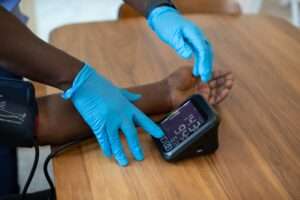
Updated April 20, 2025
In today’s connected healthcare environment, Internet of Medical Things (IoMT) devices are transforming patient care—but they’re also opening the door to unprecedented cybersecurity risks. As these devices become essential to diagnostics, monitoring, and treatment, threat actors are increasingly targeting them. When an IoMT device is compromised, not just data is at risk—it’s patient safety.
The Rise of IoMT in Healthcare: Innovation Meets Vulnerability
Today’s healthcare systems rely heavily on the IoMT— an expanding ecosystem of connected medical devices that power critical functions across hospitals, clinics, and remote care settings. These devices deliver real-time diagnostics, automate treatment, streamline care coordination, and ultimately save lives.
From heart monitors transmitting live vitals to central systems, to infusion pumps that notify clinicians when dosages shift, to smart surgical robots and wireless implantables, the IoMT revolution is well underway.
But with this innovation comes a new — and growing — threat: cybersecurity risk.
⚠️ Every Connected Device Is a Cyber Attack Surface
Each IoMT device added to a healthcare network increases your attack surface. Unlike traditional IT systems, these devices often:
- Run on outdated or unsupported software
- Lack basic authentication and encryption
- Don’t support real-time patching or remote updates
- Operate in life-critical environments where failure isn’t an option
Without robust cybersecurity controls and real-time vulnerability monitoring, these devices expose your organization to:
- Stolen or manipulated patient data, violating HIPAA and privacy laws
- Device malfunctions that interrupt treatment, putting patients at immediate risk
- Regulatory non-compliance, leading to warning letters, recalls, and public safety alerts
- Financial and reputational damage, from breaches and legal fallout
🛡️ IoMT Security Is No Longer Optional — It’s Mission-Critical
Regulators like the FDA are tightening guidance, cybercriminals are shifting their targets, and most hospital systems simply aren’t equipped to manage thousands of medical devices across multiple vendors, models, and software stacks.
Healthcare providers, device manufacturers, and hospital security teams are turning to Blue Goat Cyber.
What’s at Stake: The Real-World Risks of Unsecured IoMT Devices
Let’s make this real.
In 2017, the WannaCry ransomware attack crippled hospitals across the UK. Connected medical devices became inoperable, critical surgeries were canceled, and patient care ground to a halt. It wasn’t just a warning — it was a full-scale emergency.
Now, fast-forward to today’s even more connected landscape. With hundreds or thousands of IoMT devices deployed in every healthcare environment, the stakes have never been higher.
The Risks of Insecure IoMT Environments
🔓 Patient Data Breaches
Cybercriminals target electronic health records and PHI — exposing hospitals to HIPAA violations, identity theft lawsuits, and irreparable loss of trust.
⚙️ Device Manipulation & Tampering
A compromised medical device isn’t just a technical failure — it’s a clinical emergency. Hackers can interfere with readings, disrupt treatment, or alter functionality.
🌐 Network-Wide Takeovers
A single unprotected infusion pump or monitor can be a backdoor into your broader hospital network — leading to widespread disruption or ransomware lockouts.
🛡 Proactive Defense: How to Protect IoMT Devices (and Your Patients)
At Blue Goat Cyber, we help organizations take decisive steps toward IoMT security and FDA-aligned compliance. Here are the key best practices we deliver and recommend:
🔁 Keep Software Updated
Regular firmware and patch management closes known vulnerabilities before attackers can exploit them.
🔑 Implement Strong Authentication
Use two-factor authentication, certificates, and even biometrics — not just passwords.
🧱 Segment Your Networks
Isolate IoMT devices from core hospital networks to limit lateral movement if one device is compromised.
👁 Deploy Continuous Monitoring
Real-time logging and anomaly detection helps spot threats before they escalate.
👨⚕️ Train Clinical and IT Teams
Human error is still one of the top risks. Security awareness and incident protocols are essential.
Collaboration is the New Cybersecurity Standard
Securing medical devices isn’t just the job of the hospital or the manufacturer — it’s a shared responsibility.
-
Manufacturers must build in security from the design phase: encryption, SBOMs, patchability, and authentication must be part of the product, not an afterthought.
-
Healthcare providers must demand secure devices, maintain proper patching and monitoring, and enforce internal policies that support cybersecurity best practices.
Conclusion
The Internet of Medical Things redefines healthcare, delivering speed, precision, and lifesaving capabilities we could only imagine a decade ago. But with that innovation comes responsibility.
Every connected device is a potential point of failure — and a potential target. Without proactive, collaborative cybersecurity, the tools designed to save lives can be turned against the systems they support.
The solution isn’t fear — it’s foresight.
By embedding security into design, demanding accountability from vendors, and implementing strong postmarket defenses, healthcare leaders can protect not just data and infrastructure, but patients.
At Blue Goat Cyber, we’re here to help lead that charge — securing medical devices isn’t just what we do. It’s our mission.
Securing IoMT FAQs
IoMT (Internet of Medical Things) refers to connected medical devices that collect, share, or transmit data — such as infusion pumps, monitors, wearables, and imaging equipment. They’re vulnerable because many were not built with security in mind, lack patching capabilities, and often operate on outdated or unsupported software.
Risks include:
-
Unauthorized access to patient data (HIPAA violations)
-
Device manipulation (affecting diagnosis or treatment)
-
Network entry points for ransomware attacks
-
Regulatory non-compliance and product recalls
Secure design starts with:
-
Incorporating cybersecurity into the Secure Product Development Framework (SPDF)
-
Building Software Bills of Materials (SBOMs)
-
Using secure coding practices, encryption, and authentication
-
Ensuring devices are patchable and support remote updates
The FDA provides guidance for premarket and postmarket cybersecurity requirements. It now mandates SBOMs for cyber devices and expects proactive vulnerability management, coordinated disclosure processes, and real-time monitoring capabilities.
Segmentation isolates medical devices from the core IT infrastructure. If one device is compromised, it prevents lateral movement across the hospital network — minimizing damage and response time.
An SBOM (Software Bill of Materials) is a detailed list of all software components in a device. It helps identify known vulnerabilities (CVEs), track open-source dependencies, and is now required by the FDA for cyber device submissions.
Through a combination of:
-
Asset inventory and device visibility tools
-
Continuous vulnerability monitoring
-
Patch management programs
-
Third-party risk assessments Blue Goat Cyber offers custom portals to monitor these risks in real time.
Consequences may include:
-
Patient harm due to altered treatment
-
Data breaches and HIPAA violations
-
Device shutdowns or network-wide outages
-
Costly fines, lawsuits, or regulatory action
-
Keep firmware and software regularly updated
-
Enforce strong authentication (not just default passwords)
-
Train staff on cybersecurity hygiene
-
Monitor for anomalies 24/7
-
Work with cybersecurity experts to manage risks
We specialize exclusively in medical device cybersecurity — offering:
-
SBOM generation, risk analysis, and FDA-ready documentation
-
Postmarket vulnerability monitoring and compliance support
-
Penetration testing tailored for medical devices
-
Expert guidance through FDA cybersecurity expectations and beyond
